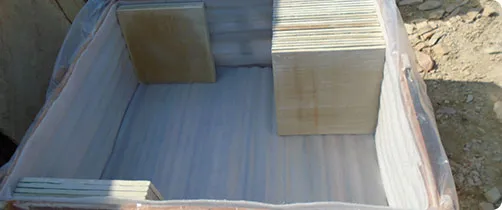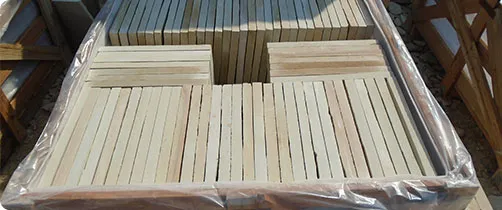Packaging Unit
Reliable packing process for a safe transit
Regatta Universal Exports understands what buyers expect when it comes to packing dimension stones, such as granite and marble. That is why we give prime importance to stone packing taking its utmost care. Though stones are pretty hard in nature, they are susceptible to damages during several phases of loading, unloading, and long road/sea transportation. Right from the time of loading at the natural stone factories until their unloading at the clients’ site, stone products are subjected to harsh treatments as they cover thousands of miles through rough sea routes. It, therefore, becomes imperative to focus on stone packing for safety, which ensures their intact deliveries at a desired location around the world. We use the following packing materials to ensure the extra safety of stone products.
Our 6-step stone packaging process
It is our constant endeavor to deliver quality products to our clients which encourages us to focus on quality at every step of project completion including packaging. From the initial crate preparation to packaging the product, our comprehensive and meticulous approach to natural stone packaging ensures the final delivery of the consignment in an untouched condition.
So, let’s take a look at the different steps of the packaging process of natural stone tiles adopted at Regatta Universal Exports.
1. Crate setup
These highly reinforced seaworthy wooden crates are manufactured using solid eucalyptus wood, ensuring sturdiness, flexibility, and safety for the packed natural stones inside.


2. Crate preparation for stone packing
The next step is to secure the inner part of the crate by using a polythene and foam sheet on all sides which helps in preventing the damage of stone edges.
3. Placing the natural stone products in the crate
Now, the natural stone tiles are systematically put in the crate to ensure the maximum utilization of the available space.


4. Filling the crate with natural stone tiles
Once a filling pattern is fixed, all the tiles are placed tightly in the crate to avoid damage. In case of gaps, foam sheets are used to secure the tile surfaces from getting damaged.
5. Securing the crate
After the crate is filled, the next thing is to secure the packed products by putting a foam sheet and polythene sheet on top of the crate. This helps in avoiding any kind of accidental damage during transit. Also, the crates are chemically treated and fumigated before dispatch.


6. Sealing the crate
Eventually, the crate is sealed by fixing the upper part using nails. Another layer of polythene sheet is used from the outside to prevent exposure to the sun, water, and cold. Packaging straps are used to secure the crate from all sides.
